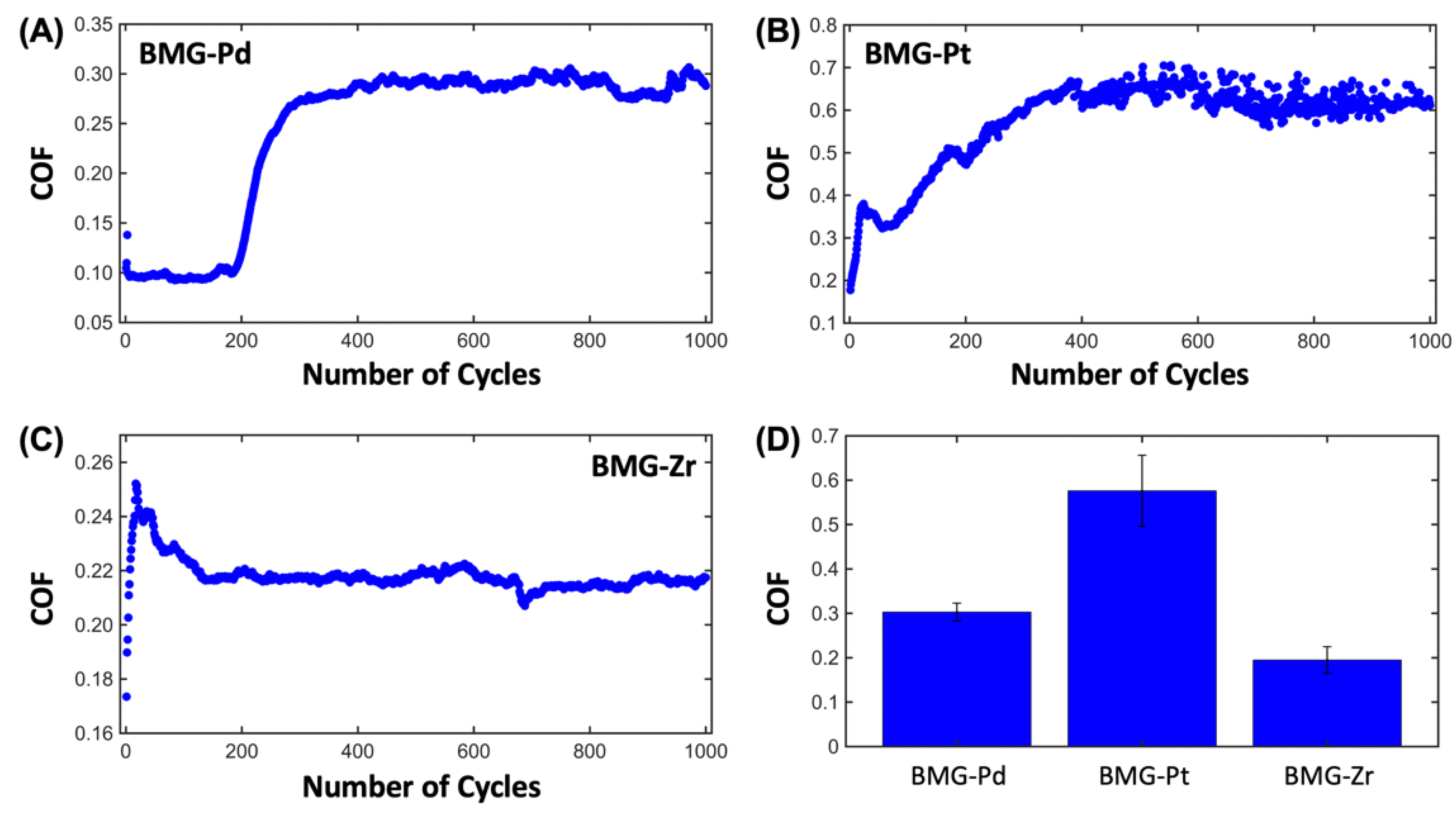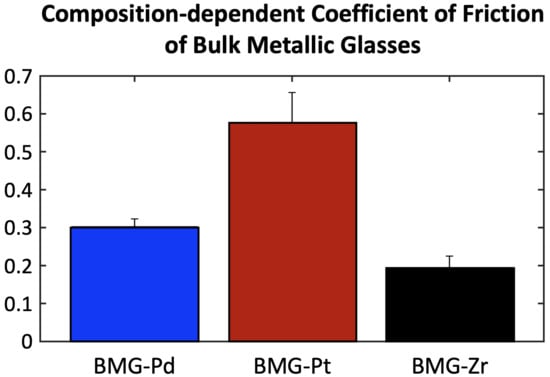Comparative Tribological Properties of Pd-, Pt-, and Zr-Based Bulk Metallic Glasses
Abstract
:1. Introduction
2. Materials and Methods
2.1. Sample Preparation
2.2. Coefficient of Friction Measurements via Micro-Tribometry
2.3. Roughness Measurements via Atomic Force Microscopy
2.4. Scanning Electron Microscopy and Energy-Dispersive X-ray Spectroscopy Measurements
3. Results and Discussion
3.1. Coefficient of Friction
3.2. Surface Roughness
3.3. Wear Behavior
4. Conclusions
Author Contributions
Funding
Acknowledgments
Data Availability Statement
Conflicts of Interest
References
- Inoue, A.; Takeuchi, A. Recent development and application products of bulk glassy alloys. Acta Mater. 2011, 59, 2243–2267. [Google Scholar] [CrossRef]
- Schuh, C.A.; Hufnagel, T.C.; Ramamurty, U. Mechanical behavior of amorphous alloys. Acta Mater. 2007, 55, 4067–4109. [Google Scholar] [CrossRef]
- Schroers, J. Processing of bulk metallic glass. Adv. Mater. 2010, 22, 1566–1597. [Google Scholar] [CrossRef] [PubMed]
- Kumar, G.; Desai, A.; Schroers, J. Bulk metallic glass: The smaller the better. Adv. Mater. 2011, 23, 461–476. [Google Scholar] [CrossRef] [PubMed]
- Li, R.; Chen, Z.; Datye, A.; Simon, G.H.; Ketkaew, J.; Kinser, E.; Liu, Z.; Zhou, C.; Dagdeviren, O.E.; Sohn, S.; et al. Atomic imprinting into metallic glasses. Commun. Phys. 2018, 1, 75. [Google Scholar] [CrossRef]
- Fu, X.Y.; Kasai, T.; Falk, M.L.; Rigney, D.A. Sliding behavior of metallic glass. Part I. Experimental investigations. Wear 2001, 250, 409–419. [Google Scholar] [CrossRef]
- Blau, P.J. Friction and wear of a Zr-based amorphous metal alloy under dry and lubricated conditions. Wear 2001, 250, 431–434. [Google Scholar] [CrossRef]
- Parlar, Z.; Bakkal, M.; Shih, A.J. Sliding tribological characteristics of Zr-based bulk metallic glass. Intermetallics 2008, 16, 34–41. [Google Scholar] [CrossRef]
- Prakash, B. Abrasive wear behaviour of Fe, Co and Ni based metallic glasses. Wear 2005, 258, 217–224. [Google Scholar] [CrossRef]
- Rahaman, M.L.; Zhang, L.C.; Ruan, H.H. Understanding the friction and wear mechanisms of bulk metallic glass under contact sliding. Wear 2013, 304, 43–48. [Google Scholar] [CrossRef]
- Tariq, N.H.; Hasan, B.A.; Akhter, J.I.; Ali, F. Mechanical and tribological properties of Zr-Al-Ni-Cu bulk metallic glasses. J. Alloys Compd. 2009, 469, 179–185. [Google Scholar] [CrossRef]
- Zhang, G.Q.; Li, X.J.; Shao, M.; Wang, L.N.; Yang, J.L.; Gao, L.P.; Chen, L.Y.; Liu, C.X. Wear behavior of a series of Zr-based bulk metallic glasses. Mater. Sci. Eng. A 2008, 475, 124–127. [Google Scholar] [CrossRef]
- Lee, J.; He, M.; Yeo, C.D.; Kumar, G.; Hu, Z.; Quitevis, E.L.; Thalangamaarachchige, V.D. Friction and wear of Pd-rich amorphous alloy (Pd43Cu27Ni10P20) under dry and ionic liquid (IL) lubricated conditions. Wear 2018, 408, 190–199. [Google Scholar] [CrossRef]
- Lee, J.; Yeo, C.D.; Hu, Z.; Thalangama-Arachchige, V.D.; Kaur, J.; Quitevis, E.L.; Kumar, G.; Koh, Y.P.; Simon, S. Friction and wear of pd-rich amorphous alloy (Pd43Cu27Ni10P20) with ionic liquid (IL) as lubricant at high temperatures. Metals 2019, 9, 1180. [Google Scholar] [CrossRef] [Green Version]
- Wang, Y.; Zhang, L.; Wang, T.; Hui, X.D.; Chen, W.; Feng, C.F. Effect of sliding velocity on the transition of wear mechanism in (Zr, Cu)95Al5 bulk metallic glass. Tribol. Int. 2016, 101, 141–151. [Google Scholar] [CrossRef]




© 2020 by the authors. Licensee MDPI, Basel, Switzerland. This article is an open access article distributed under the terms and conditions of the Creative Commons Attribution (CC BY) license (http://creativecommons.org/licenses/by/4.0/).
Share and Cite
Medina, M.A.; Acikgoz, O.; Rodriguez, A.; Meduri, C.S.; Kumar, G.; Baykara, M.Z. Comparative Tribological Properties of Pd-, Pt-, and Zr-Based Bulk Metallic Glasses. Lubricants 2020, 8, 85. https://doi.org/10.3390/lubricants8090085
Medina MA, Acikgoz O, Rodriguez A, Meduri CS, Kumar G, Baykara MZ. Comparative Tribological Properties of Pd-, Pt-, and Zr-Based Bulk Metallic Glasses. Lubricants. 2020; 8(9):85. https://doi.org/10.3390/lubricants8090085
Chicago/Turabian StyleMedina, Marco A., Ogulcan Acikgoz, Anthony Rodriguez, Chandra S. Meduri, Golden Kumar, and Mehmet Z. Baykara. 2020. "Comparative Tribological Properties of Pd-, Pt-, and Zr-Based Bulk Metallic Glasses" Lubricants 8, no. 9: 85. https://doi.org/10.3390/lubricants8090085
APA StyleMedina, M. A., Acikgoz, O., Rodriguez, A., Meduri, C. S., Kumar, G., & Baykara, M. Z. (2020). Comparative Tribological Properties of Pd-, Pt-, and Zr-Based Bulk Metallic Glasses. Lubricants, 8(9), 85. https://doi.org/10.3390/lubricants8090085








